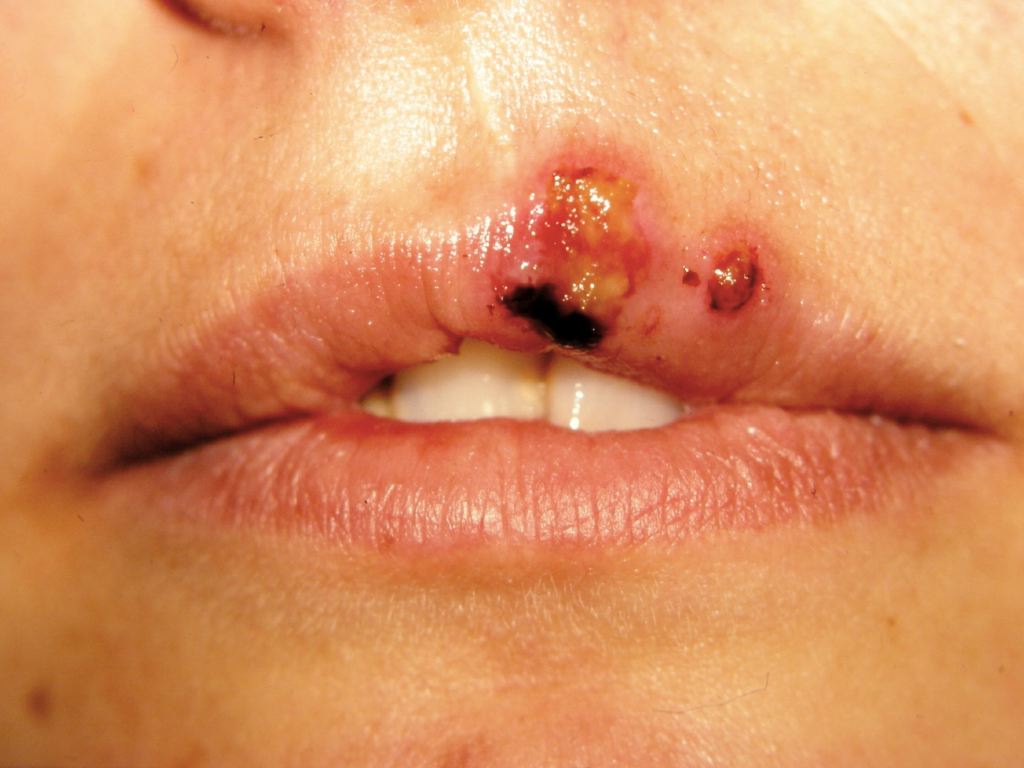Introduction
Herpes genitalis can be caused by the herpes simplex virus type 1 or 2, manifesting as a primary or recurrent infection.[1] Most commonly, viral replication occurs in epithelial tissue and establishes dormancy in sensory neurons, reactivating periodically as localized recurrent lesions.[2] It remains one of the most common sexually transmitted infections (STI) but continues to be underestimated, given the vague presentation of its symptoms.[3] In addition to providing the reader with basic knowledge of the pathogen and clinical presentation of herpes genitalis, this review article discusses important aspects of laboratory diagnostics, antiviral therapy, and prophylaxis. This article is aimed at all healthcare providers managing patients with herpes genitalis and attempts to improve the often suboptimal counseling and targeted use of laboratory diagnostics, treatment, and preventive measures provided to patients.
Herpes simplex virus type 2 (HSV-2) continues to be a common infection, affecting approximately 22% of adults ages 12 and older, representing 45 million adults in the United States alone.[4] While HSV-1 often affects the perioral region and can be known to cause genital lesions, HSV-2 is more commonly the consideration when patients present with genital lesions. Despite this, most infection outbreaks will present with nonspecific symptoms such as genital itching, irritation, and excoriations, which may cause diagnosis and treatment to be delayed.[4] As a result, further exposure to uninfected individuals may occur.
Etiology
Register For Free And Read The Full Article
Search engine and full access to all medical articles
10 free questions in your specialty
Free CME/CE Activities
Free daily question in your email
Save favorite articles to your dashboard
Emails offering discounts
Learn more about a Subscription to StatPearls Point-of-Care
Etiology
Risk factors for acquiring HSV-2 infection involve direct exposure to fluids (i.e., saliva) from a seropositive individual containing viral products, most often during sexual intercourse.[3] HSV-2 is mainly transmitted through sexual intercourse, attributing to its predominant rise starting at puberty.[3] Due to its low stability outside the body, HSV can only remain infectious for days on moist surfaces. Therefore, modes of transmission other than sexual intercourse are often insignificant.[3] Both primary and recurrent HSV infections in pregnant women can lead to intrauterine transmission and resultant congenital HSV infection.[5]
Epidemiology
Herpes genitalis remains among the most common sexually transmitted infections (STI).[3] While the majority of cases are due to HSV-2, rare but increasing cases have been found due to herpes simplex virus type 1 (HSV-1).[3] The primary mode of transmission of both HSV-1 and HSV-2 is via direct contact with open lesions. Sixteen percent of patients aged 14 to 49 were reported to be seropositive for HSV-2 from 2005 to 2010.[6] Antibodies to HSV-2 are often present by the time of puberty, and their presence often correlates with the degree of sexual activity of that individual. More women than men have been reported to be infected, and as expected, the prevalence increases with an increasing number of sexual partners. [7] Ethnically, non-Hispanic African Americans have greater rates of infection than non-Hispanic Whites. About 85% to 90% of infections are unrecognized and remain undiagnosed.[8]
In the United States, HSV remains one of the most common causes of genital ulcers; internationally, more than 23 million new cases are reported annually.[9]
Pathophysiology
HSV-2 is transmitted through direct contact with secretions in a seropositive individual who is actively shedding the virus. The virus preferentially affects the skin and mucous membranes, invading epithelial cells on initial exposure and ultimately replicating intracellularly at that site. After the initial exposure and symptoms resolve, in 10 to 14 days, on average, the virus then lays dormant in the periaxonal sheath of the sensory nerves of either the trigeminal, cervical, lumbosacral, or autonomic ganglia. In these locations, the viral replication is often controlled by the patient's immune system and remains dormant, only to reactivate later in life.[9] When reactivation does occur, the virus travels through the sensory nerves until it reaches the mucocutaneous sites, where replication then takes place and leads to vesicular clusters at the dermatological site of that sensory neuron.
Histopathology
Histological presentations of HSV-2 include the presence of dense lymphoid infiltrates with atypical lymphocytes.[10] Diagnosis is often made based on the clinical exam, but if the pathological analysis is performed, it is consistent with dense and deep infiltrates of lymphocytes near adnexal structures along with individual necrotic keratinocytes. When looking at the surface of cells, it is common to see epidermal ballooning and acantholysis, which leads to the classic vesiculation seen on the clinical exam.[11] Multinucleated giant cells and epithelial cells containing eosinophilic intranuclear inclusion bodies are seen on biopsies.
History and Physical
Genital symptoms are commonly seen in the outpatient primary care setting despite many going without a clear diagnosis. HSV-2, in particular, may present as a primary infection with painful genital ulcers, sores, crusts, tender lymphadenopathy, and dysuria.[4] The classical features are macular or papular skin and mucous membrane lesions progressing to vesicles and pustules that often last up to 3 weeks. Genital lesions can be especially painful, leading to swelling of the vulva in women, burning pain, and dysuria.[12]
It is important to note that HSV-2 does not typically present with painless ulcers. Systemic symptoms can occur, including fever, headache, and malaise, and are often due to concurrent viremia, which has been reported in up to 24% of patients in one study.[13]
Evaluation
Laboratory Assessments
- A direct swab of vesicular lesions (within 72 hours of onset) is ideal, but avoid lesions that have evidence of crusting or healing. Do not clean the area with topical alcohols before acquiring the material.
- Swab locations include: skin via unroofing vesicles with a sterile needle, urethra via sterile swab, the cervix through the vaginal speculum, urine, swabbing of the conjunctiva, and rectal swabs through proctoscopes [14]
- HSV PCR (if a direct swab is not possible, PCR is the test of choice)
- Tzank smear - low sensitivity and cannot decipher between HSV serotypes
- Direct fluorescent antigen
- HSV serotyping
- Antibody testing [15][16]
Given symptoms can mimic acute urinary tract infection, consider urinalysis and culture.
Given HSV is a sexually transmitted infection (STI), consider further STI workup to include:
- Gonorrhea/chlamydia testing (urine)
- HIV (known interaction between HSV-2 and HIV in which concurrent infection may occur faster than if HSV-2 was not present)
- RPR
Treatment / Management
Management of genital herpes centers around preventing its transmission and suppressing viral shedding through antiviral therapy and counseling regarding the risk of sexual transmission.
Primary Treatment
Primary infections with multiple ulcerating lesions will resolve after approximately 19 days, regardless of treatment interventions.[12] Treatments are typically categorized as either primary or non-primary. Primary infection is when the individual is experiencing their first outbreak (previously seronegative for HSV). Secondary (or non-primary) is an infection in a patient with preexisting immunity. Treatment is similar for both patient populations.
Antiherpesviral agents include those that act as nucleoside analog-polymerase inhibitors and pyrophosphate analog–polymerase inhibitors. The mainstay of therapy remains acyclovir, which has antiviral activity against all herpesviruses and has been FDA-approved for treating and suppressing both HSV and VZV.[17] Other treatments include penciclovir (which is more often used as a topical therapy for HSV labialis) and ganciclovir (which has suppression activity against CMV). These medications are preferentially taken up by those cells already infected with the virus and stop viral replication. [17] Treatment should be offered to all patients to prevent a prolonged duration of their symptoms, ideally immediately after the appearance of the first lesion.[1]
- Acyclovir: available in topical, oral, and IV formulations. The oral formulation has quite a poor bioavailability, which has been improved with valacyclovir (see below). The benefits of acyclovir include its low side effect profile, which allows it to be tolerated for long periods. Suppressive treatment with acyclovir can prevent or delay up to 80% of recurrences, thus reducing shedding by greater than 90%.[18] Reported side effects include kidney toxicity and neutropenia when given at high doses.[17] Given its chronicity of use, resistance has been reported in immunocompromised patients and those who are immunocompetent taking acyclovir as suppressive therapy for genital herpes.[17]
- Primary herpes genitalis: 3 x 400 mg tablets PO daily for 7 to 10 days
- Severe primary herpes genitalis: 3 x 5 mg/kg IV daily for 5 to 7 days
- Recurrent herpes genitalis (less than 5 to 6 episodes/year): 400 mg PO twice a day for 3 days
- Prophylaxis: 2 x 400 mg PO daily for 6 months
- Valacyclovir is another formulation option that is attractive to patients
- Primary herpes genitalis: 2 x 500 mg tablets PO daily for 7 to 10 days
- Recurrent herpes genitalis (less than 5 to 6 episodes/year): 2 x 500 mg PO twice daily for 3 days
- or
- 1 x 1000 mg tablet daily for 5 days
Prophylaxis: 1 x 500 mg PO daily for 6 months
Treatments on the Horizon
Standard therapy for herpes simplex virus type 2 infections includes acyclovir and valacyclovir. Medications on the horizon include brincidofovir and maribavir (both against CMV) and valomaciclovir (activity against HSV, VZV, and EBV). As patients seek alternative treatments with a smaller adverse effect profile, essential oils have been a focus of interest.[19] HSV has demonstrated susceptibility to many essential oils and their constituents through both direct virucidal activity and inhibition of intracellular replication.[19] Topical peppermint oil has been studied due to its virucidal component, with antiviral activity reported at 99% after only 3 hours of exposure.[20] However, the stipulation of use and activity was that peppermint oil was only effective against the virus before absorption into the host cell. As a result, it may be of particular benefit from a chronic suppressive treatment rather than post-infectious symptoms. Other oils found to have antiviral effects against HSV include Australian tea tree oil and eucalyptus oil.[21](B3)
Vaccinations
HSV vaccines are being studied to reduce the severity of symptoms and to help expedite visible lesion healing. Furthermore, by reducing shedding, the severity may be reduced, as has been seen with the Varicella-zoster vaccination.[2] No current vaccine is available for HSV.
Differential Diagnosis
Infectious genital ulcerative conditions
-
- Syphilis
- Chancroid
- Lymphogranuloma venereum
- Granuloma inguinale
- Non-infectious genital ulcerative conditions
- Crohn disease
- Behcet syndrome
- Fixed drug eruptions
- Psoriasis
- Sexual trauma
Genital HSV-2 infection is associated with an increased risk of HIV infection. As a result, be aware that testing for HIV infection may alter the treatment of HSV-2.[22]
Prognosis
There is no cure for HSV-2; early identification of symptoms and prompt institution of pharmacotherapy can lead to early suppression of viral replication. Abstinence during known viral shedding can decrease the risk of transmission to a seronegative partner. The herpes viruses as a family are responsible for significant neurological morbidity, and unfortunately, HSV-2 persists in the seropositive individual for a lifetime.
Complications
- Genital HSV-2 infection is known to be associated with an increased risk of HIV infection. As a result, be aware that testing for HIV infection may alter the treatment of HSV-2.[22]
- Untreated HSV-2 can cause meningitis; however, any part of the nervous system may be affected by this virus.
- Aseptic meningitis occurs in 36% of women and 13% of men, leading to the hospitalization of a percentage of inflicted persons. During the prodrome of genital herpes and herpetic eruption, as discussed above, affected individuals may experience more systemic symptoms such as headaches, neck stiffness, and low-grade fever. Such symptoms should lead to immediate lumbar puncture with an analysis of the CSF, often revealing a lymphocytic pleocytosis. While the CSF can be sent for viral culture, PCR is the recommended diagnostic modality.[8]
- Acute retinal necrosis - presents with a unilateral or bilateral red eye(s), periorbital pain, and impaired visual acuity. Examination reveals episcleritis or scleritis and necrosis with retinal detachment. It may occur with HSV-2 meningoencephalitis.[8]
Deterrence and Patient Education
Key educational facts to consider are as follows:
- Condom use is recommended.
- Abstain from sexual activity during periods of known active viral shedding (visible lesions).
- Consider prophylactic suppressive therapy if frequent sexual activity is likely to occur.[23]
Pearls and Other Issues
Key facts to keep in mind are as follows:
- HSV cannot be cured, but suppressive therapy can help prevent the spread to seronegative individuals.
- HSV has been associated with HIV infection, and thus, patients with a new diagnosis of HSV should have full STI workups performed.
Enhancing Healthcare Team Outcomes
The primary care physician or provider will often be the first one to diagnose and treat HSV-2 infections. However, an interprofessional team approach is the optimal means to address this condition.
- Early identification of the classical vesicular lesions can lead to prompt treatment and potentially prevent spread to seronegative individuals.
- The interprofessional healthcare team, including the medical assistants and nursing staff, is pivotal in educating patients on preventing unnecessary spread. This should be documented and communicated to the treating physician.
- Utilizing network public health officials can help dispense information and track STIs in the area, leading to early identification in patients who may be otherwise asymptomatic.
- Pharmacists review medications, verify dosing, check for interactions, and inform patients about use and potential side effects. They also may be involved in purchasing condoms and can make patient recommendations.
Media
(Click Image to Enlarge)
(Click Image to Enlarge)
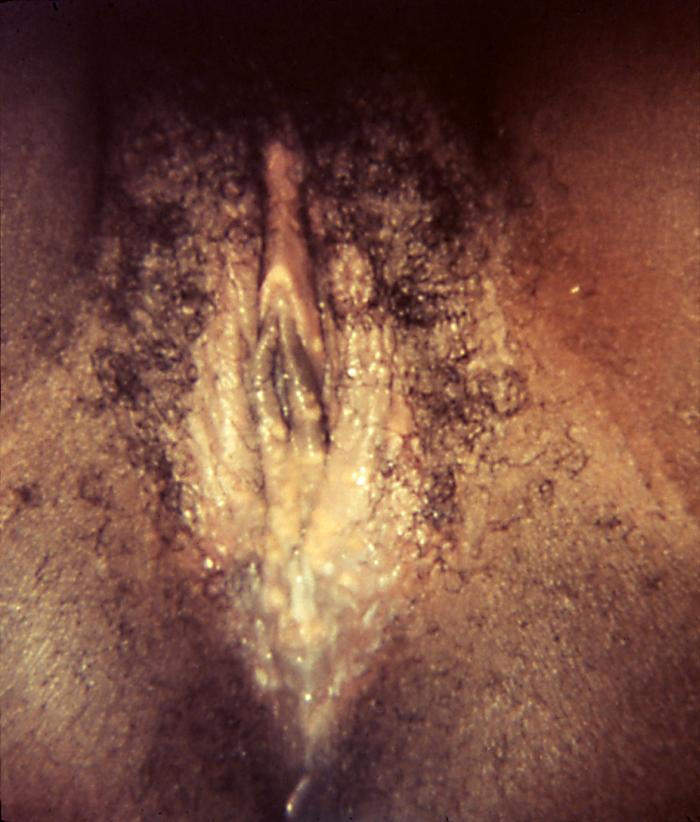
This photograph depicted a close view of a patient’s vulva, revealing evidence of an outbreak of herpes genitalis, which had manifested as a pustular-vesicular rash around the vaginal introitus due to the herpes simplex virus type-2 (HSV-2) virus.
Contributed from the CDC/ Susan Lindsley (Public Domain)
(Click Image to Enlarge)
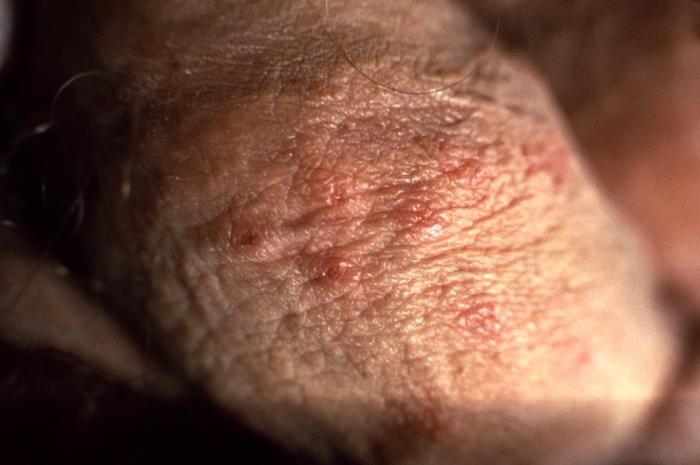
This image depicts a close view of a patient’s penile shaft, highlighting the presence of a crop of erythematous vesiculopapular lesions, which were determined to have been caused by a herpes genitalis outbreak. Genital herpes is a sexually transmitted disease caused by the herpes simplex viruses type-1 (HSV-1), and type-2 (HSV-2), however, most genital herpes is caused by HSV-2. Symptoms typically include one or more blisters on or around the genitals or rectum. Contributed from the CDC/ Susan Lindsley (Public Domain)
(Click Image to Enlarge)
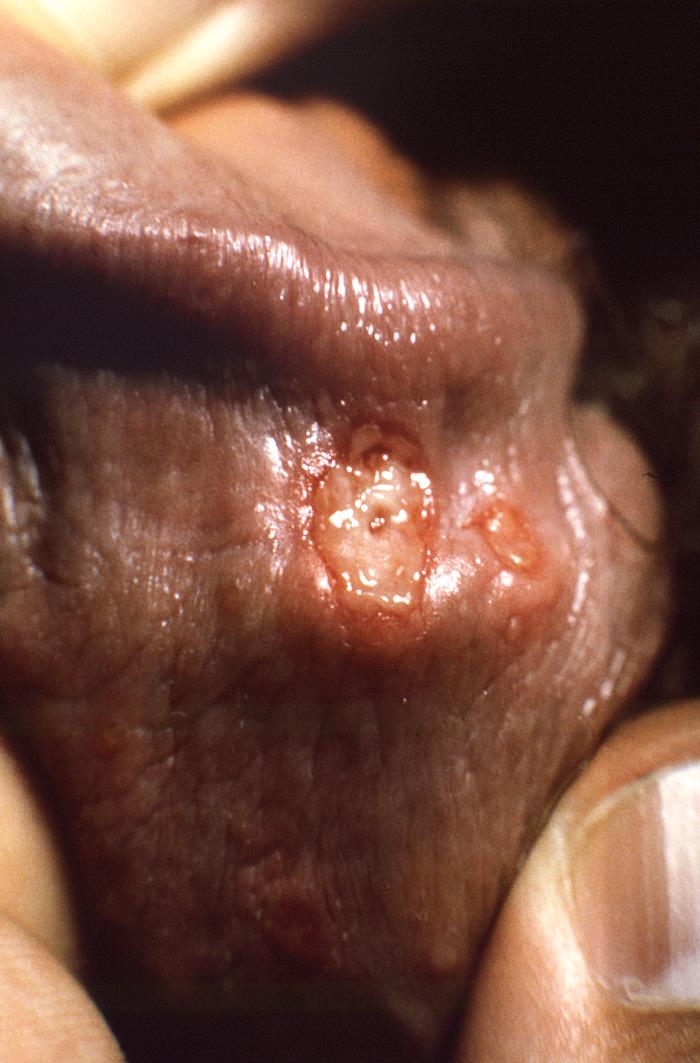
This was an outbreak of herpes genitalis, which had manifested as blistering on the underside of the penile shaft, just proximal to the corona of the glans, which was due to the herpes simplex 2 (HSV-2) virus, otherwise referred to as genital herpes. Sexually transmitted herpes simplex HSV-2, typically causes one or more blisters to form on, or around the genitals or rectum, which break, leaving tender ulcers that may take 2 to 4-weeks to heal after making their initial appearance. Contributed from the CDC/ Susan Lindsley (Public Domain)
(Click Image to Enlarge)
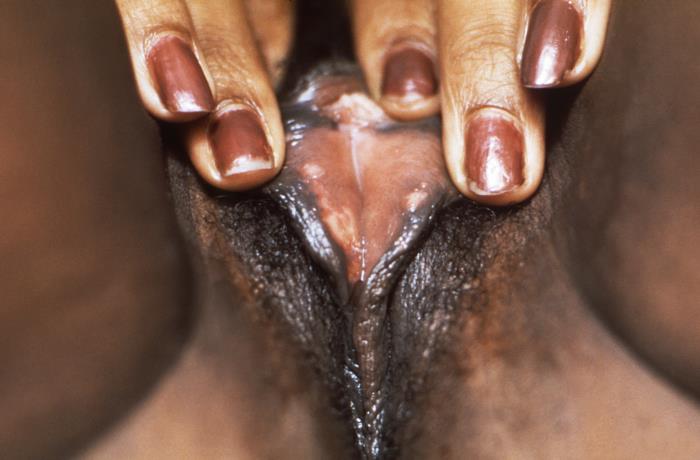
This image depicts a close view of a female’s perineum, revealing what had been an outbreak of herpes genitalis, which had manifested as blistering around the vaginal introitus due to the herpes simplex 2 (HSV-2) virus, otherwise referred to as genital herpes. Sexually transmitted herpes simplex HSV-2, typically causes one or more blisters to form on, or around the genitals or rectum, which break, leaving tender ulcers that may take 2 to 4-weeks to heal after making their initial appearance. Contributed from the CDC/ Susan Lindsley (Public Domain)
References
Workowski KA, Bolan GA, Centers for Disease Control and Prevention. Sexually transmitted diseases treatment guidelines, 2015. MMWR. Recommendations and reports : Morbidity and mortality weekly report. Recommendations and reports. 2015 Jun 5:64(RR-03):1-137 [PubMed PMID: 26042815]
Whitley R, Baines J. Clinical management of herpes simplex virus infections: past, present, and future. F1000Research. 2018:7():. pii: F1000 Faculty Rev-1726. doi: 10.12688/f1000research.16157.1. Epub 2018 Oct 31 [PubMed PMID: 30443341]
Sauerbrei A. Herpes Genitalis: Diagnosis, Treatment and Prevention. Geburtshilfe und Frauenheilkunde. 2016 Dec:76(12):1310-1317. doi: 10.1055/s-0042-116494. Epub 2016 Oct 18 [PubMed PMID: 28017972]
Fleming DT, Leone P, Esposito D, Heitman CK, Justus S, Chin S, Fife KH. Herpes virus type 2 infection and genital symptoms in primary care patients. Sexually transmitted diseases. 2006 Jul:33(7):416-21 [PubMed PMID: 16601657]
Anzivino E, Fioriti D, Mischitelli M, Bellizzi A, Barucca V, Chiarini F, Pietropaolo V. Herpes simplex virus infection in pregnancy and in neonate: status of art of epidemiology, diagnosis, therapy and prevention. Virology journal. 2009 Apr 6:6():40. doi: 10.1186/1743-422X-6-40. Epub 2009 Apr 6 [PubMed PMID: 19348670]
Bradley H, Markowitz LE, Gibson T, McQuillan GM. Seroprevalence of herpes simplex virus types 1 and 2--United States, 1999-2010. The Journal of infectious diseases. 2014 Feb 1:209(3):325-33. doi: 10.1093/infdis/jit458. Epub 2013 Oct 16 [PubMed PMID: 24136792]
Level 2 (mid-level) evidenceCenters for Disease Control and Prevention (CDC). Seroprevalence of herpes simplex virus type 2 among persons aged 14-49 years--United States, 2005-2008. MMWR. Morbidity and mortality weekly report. 2010 Apr 23:59(15):456-9 [PubMed PMID: 20414188]
Level 2 (mid-level) evidenceBerger JR, Houff S. Neurological complications of herpes simplex virus type 2 infection. Archives of neurology. 2008 May:65(5):596-600. doi: 10.1001/archneur.65.5.596. Epub [PubMed PMID: 18474734]
Level 3 (low-level) evidenceFatahzadeh M, Schwartz RA. Human herpes simplex virus infections: epidemiology, pathogenesis, symptomatology, diagnosis, and management. Journal of the American Academy of Dermatology. 2007 Nov:57(5):737-63; quiz 764-6 [PubMed PMID: 17939933]
Leinweber B, Kerl H, Cerroni L. Histopathologic features of cutaneous herpes virus infections (herpes simplex, herpes varicella/zoster): a broad spectrum of presentations with common pseudolymphomatous aspects. The American journal of surgical pathology. 2006 Jan:30(1):50-8 [PubMed PMID: 16330942]
Level 2 (mid-level) evidenceBöer A, Herder N, Winter K, Falk T. Herpes folliculitis: clinical, histopathological, and molecular pathologic observations. The British journal of dermatology. 2006 Apr:154(4):743-6 [PubMed PMID: 16536821]
Corey L, Adams HG, Brown ZA, Holmes KK. Genital herpes simplex virus infections: clinical manifestations, course, and complications. Annals of internal medicine. 1983 Jun:98(6):958-72 [PubMed PMID: 6344712]
Johnston C, Magaret A, Selke S, Remington M, Corey L, Wald A. Herpes simplex virus viremia during primary genital infection. The Journal of infectious diseases. 2008 Jul 1:198(1):31-4. doi: 10.1086/588676. Epub [PubMed PMID: 18471083]
Level 2 (mid-level) evidenceBrown EL, Gardella C, Malm G, Prober CG, Forsgren M, Krantz EM, Arvin AM, Yasukawa LL, Mohan K, Brown Z, Corey L, Wald A. Effect of maternal herpes simplex virus (HSV) serostatus and HSV type on risk of neonatal herpes. Acta obstetricia et gynecologica Scandinavica. 2007:86(5):523-9 [PubMed PMID: 17464578]
Level 2 (mid-level) evidenceSingh A, Preiksaitis J, Ferenczy A, Romanowski B. The laboratory diagnosis of herpes simplex virus infections. The Canadian journal of infectious diseases & medical microbiology = Journal canadien des maladies infectieuses et de la microbiologie medicale. 2005 Mar:16(2):92-8 [PubMed PMID: 18159535]
Slomka MJ. Current diagnostic techniques in genital herpes: their role in controlling the epidemic. Clinical laboratory. 2000:46(11-12):591-607 [PubMed PMID: 11109508]
Poole CL, James SH. Antiviral Therapies for Herpesviruses: Current Agents and New Directions. Clinical therapeutics. 2018 Aug:40(8):1282-1298. doi: 10.1016/j.clinthera.2018.07.006. Epub 2018 Aug 10 [PubMed PMID: 30104016]
Paz-Bailey G, Ramaswamy M, Hawkes SJ, Geretti AM. Herpes simplex virus type 2: epidemiology and management options in developing countries. Sexually transmitted infections. 2007 Feb:83(1):16-22 [PubMed PMID: 17098770]
Schnitzler P. Essential Oils for the Treatment of Herpes Simplex Virus Infections. Chemotherapy. 2019:64(1):1-7. doi: 10.1159/000501062. Epub 2019 Jun 24 [PubMed PMID: 31234166]
Schuhmacher A, Reichling J, Schnitzler P. Virucidal effect of peppermint oil on the enveloped viruses herpes simplex virus type 1 and type 2 in vitro. Phytomedicine : international journal of phytotherapy and phytopharmacology. 2003:10(6-7):504-10 [PubMed PMID: 13678235]
Level 3 (low-level) evidenceSchnitzler P, Schön K, Reichling J. Antiviral activity of Australian tea tree oil and eucalyptus oil against herpes simplex virus in cell culture. Die Pharmazie. 2001 Apr:56(4):343-7 [PubMed PMID: 11338678]
Freeman EE, Weiss HA, Glynn JR, Cross PL, Whitworth JA, Hayes RJ. Herpes simplex virus 2 infection increases HIV acquisition in men and women: systematic review and meta-analysis of longitudinal studies. AIDS (London, England). 2006 Jan 2:20(1):73-83 [PubMed PMID: 16327322]
Level 1 (high-level) evidence. Summaries for patients. Condom use and genital herpes. Annals of internal medicine. 2005 Nov 15:143(10):I40 [PubMed PMID: 16287786]
